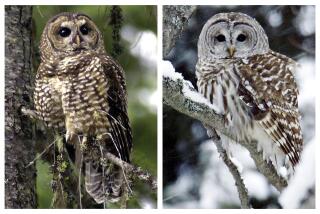Bird advocates urge mandatory standards for wind energy projects
The American Bird Conservancy on Wednesday petitioned the U.S. Department of the Interior to replace its proposed voluntary guidelines for siting and operating wind farms with mandatory enforceable standards designed to make the technology safer for wildlife including migrating birds and bats.
The 100-page petition prepared by the conservancy and the Washington-based law firm Meyer, Glitzenstein & Crystal recommends that the U.S. Fish and Wildlife Service establish a mandatory permitting system for the booming alternative energy source and mitigation of its impacts on bats and migrating birds, thousands of which are killed each year by wind turbines.
Conservancy campaign coordinator Kelly Fuller said the proposal would provide legal certainty that wind developers in compliance with a permit would not be subject to criminal or civil penalties for violation of laws including the Migratory Bird Treaty Act.
âVoluntary guidelines the government has drafted will neither protect birds nor give the wind industry the regulatory certainty it has been asking for,â Fuller said in an interview. âWeâre hoping the federal government will take a hard look at our proposal as it completes a final review of its revised proposed guidelines for wind energy projects.â
The development and delivery of renewable energy is one of the highest priorities of the Interior Department. In California, Gov. Jerry Brown in April signed into law a mandate that a third of the electricity used in California come from renewable sources, including wind and solar, by 2020.
The number of proposed turbine towers more than 200 feet tall increased nationwide from 950 in 2003, when the Fish and Wildlife Service first issued voluntary guidelines for wind energy projects, to a total 79,513 by 2010, according to the conservancy.
So far, no wind energy company has been prosecuted by federal wildlife authorities in connection with the death of birds protected by the act, the Bald and Golden Eagle Protection Act or the federal Endangered Species Act.
Nationwide, about 440,000 birds are killed at wind farms each year, according to federal wildlife authorities. Poorly sited and operated wind farms threaten birds of prey such as bald eagles, golden eagles and endangered California condors, and species of conservation concern including the cerulean warbler, Bicknellâs thrush and long-billed curlew.
âWe think this industry almost uniquely lends itself to a permitting process,â said attorney Eric Glitzenstein, who helped prepare the conservancy proposal. âRight now, the federal government is encouraging the growth of the industry in a way that also encourages violations of the Migratory Bird Treaty Act.â
The proposal ruffled the feathers of the American Wind Energy Assn., an industry lobbying group, which pointed out that far more birds are killed each year by collisions with radio towers, tall buildings, airplanes and encounters with hungry household cats.
âWe are looking forward to the Fish and Wildlife Service finalizing its wind turbine guidelines,â said John Anderson, the associationâs director of siting policy. âThese guidelines are based on recommendations from a federal advisory committee, which includes representatives from industry, environmental groups and state wildlife agencies.â
RELATED:
Eagle deaths investigated at LADWP wind power generation site
Vermont Law School top 10 environmental watch list for 2012
Are birds getting bigger because of global climate change?
-- Louis Sahagun







